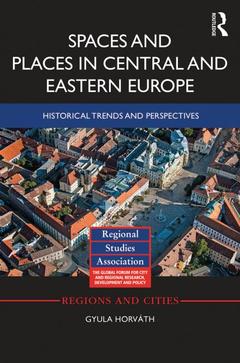Description
Spaces and Places in Central and Eastern Europe
Historical Trends and Perspectives
Regions and Cities Series
Author: Horváth Gyula
Language: English
Subjects for Spaces and Places in Central and Eastern Europe:
Keywords
RSA; Eastern Europe; Central Europe; EU Enlargement; Transition Economies; Economic Transition; Russia; Hungary; East Germany; Romania; Slovakia; Czech Republic; Regional Development; Regional Science; Regional Studies; Sally Hardy; Spatial Economics; The City; Urban Studies; SME Sector; West Germany; Public Administration; EU Cohesion Policy; EU Structural Policy; EU Cohesion; Bratislava County; Alps Adriatic Working Community; EU Average; Cee Country; EU Support; Regional Operational Programmes; Mecklenburg West Pomerania; EU’s Integration Process; Balkan Countries; Central Government; EU Accession; Carpathian Basin; Gdp Gap; Cee Region; Supreme Economic Council; High FDI; UK Labour Government; Gdp Level; Gdp Term
Publication date: 07-2014
Support: Print on demand
Publication date: 08-2018
· 15.6x23.4 cm · Paperback
Description
/li>Contents
/li>Readership
/li>Biography
/li>
Across Europe there is a rapidly changing context for undertaking regional development. In the 20th century, development of the former planned economies (Bulgaria, Czech Republic, Hungary, Poland, Romania and Slovakia), was defined by these countries differences, rather than their common ideological roots. These disparities altered over time and were marked by changing social structures. However, the ranking of regions has remained the same as core areas have strengthened their positions while the structural obstacles to the modernisation of peripheral areas have remained due to a lack of coherent regional policy.
This book examines the specific regional development paths of Central and Eastern European countries and evaluates the effects of the determining factors of this process. Through analysis of the system of objectives, instruments and institutions used in different eras, and case studies of Hungary, East Germany and Germany, development models are established and compared with Western European patterns.
The book summarises the experiences of Central and Eastern European regional cooperation and examines the basic nature of the cohesion problems of the Carpathian Basin trans-national macro region. It confirms by comparative historical analyses that the transformation was indeed unique. This book will make a welcome addition to the literature for students and academics interested in the broader picture of Central and Eastern European politics, future integration within the European Union and the history of regional development processes.
1. Regional transition in the Central and Eastern European countries 2. Regions in Central and Eastern Europe 3. Towards a Knowledge based regional development: decentralization of science and research 4. The German Mezzogiorno? The natural history of East German regional development 5. Regional transformation in Russia 6. Regionalism in a unitary state: the case of Hungary 7. Interregional cooperation in a Central European macro-region: the case of the Carpathian Basin
Gyula Horváth is Professor in Regional Economics and Policy of the University of Pécs, Hungary and Scientific advisor of Institute of Regional Studies, Hungarian Academy of Sciences.



